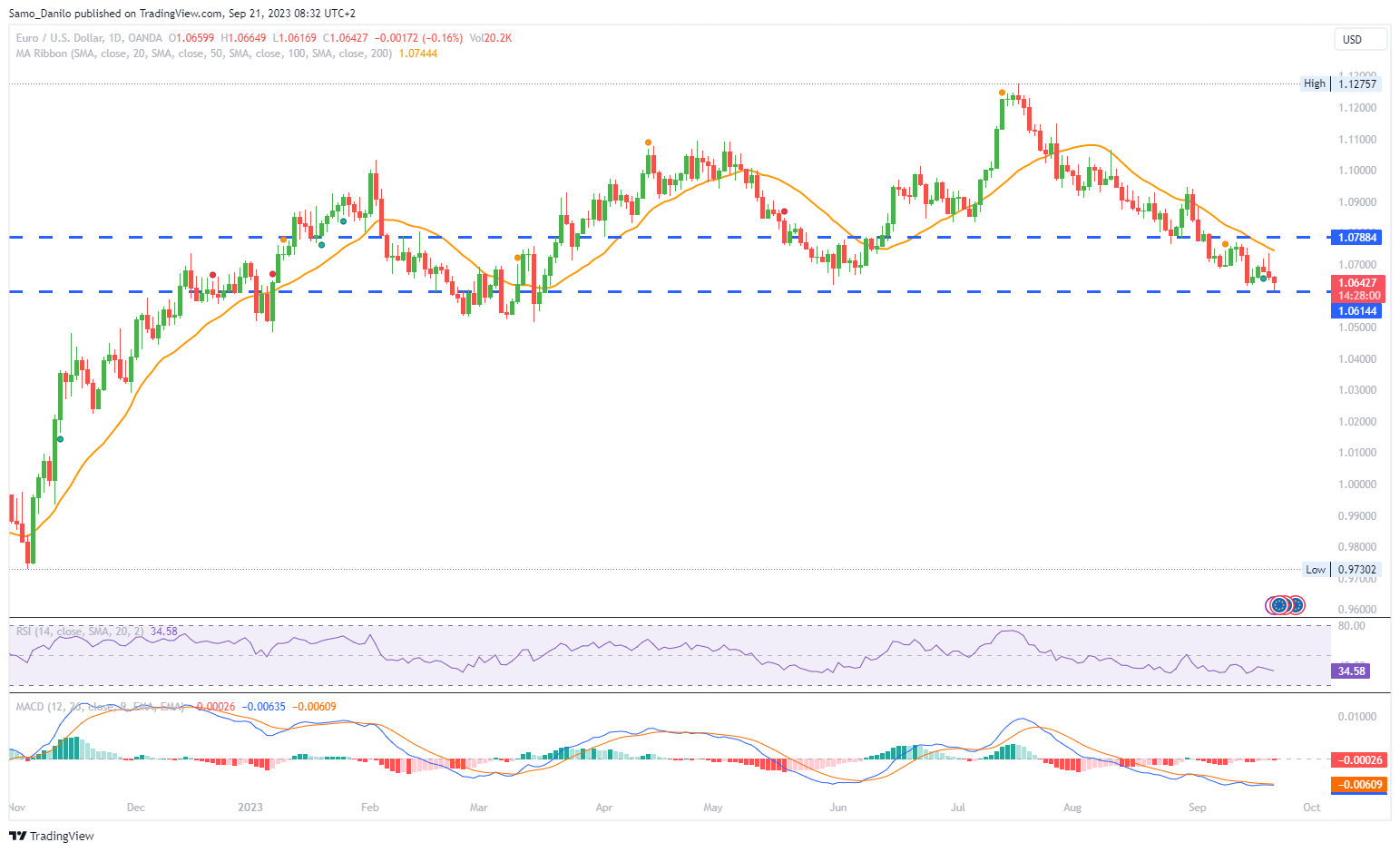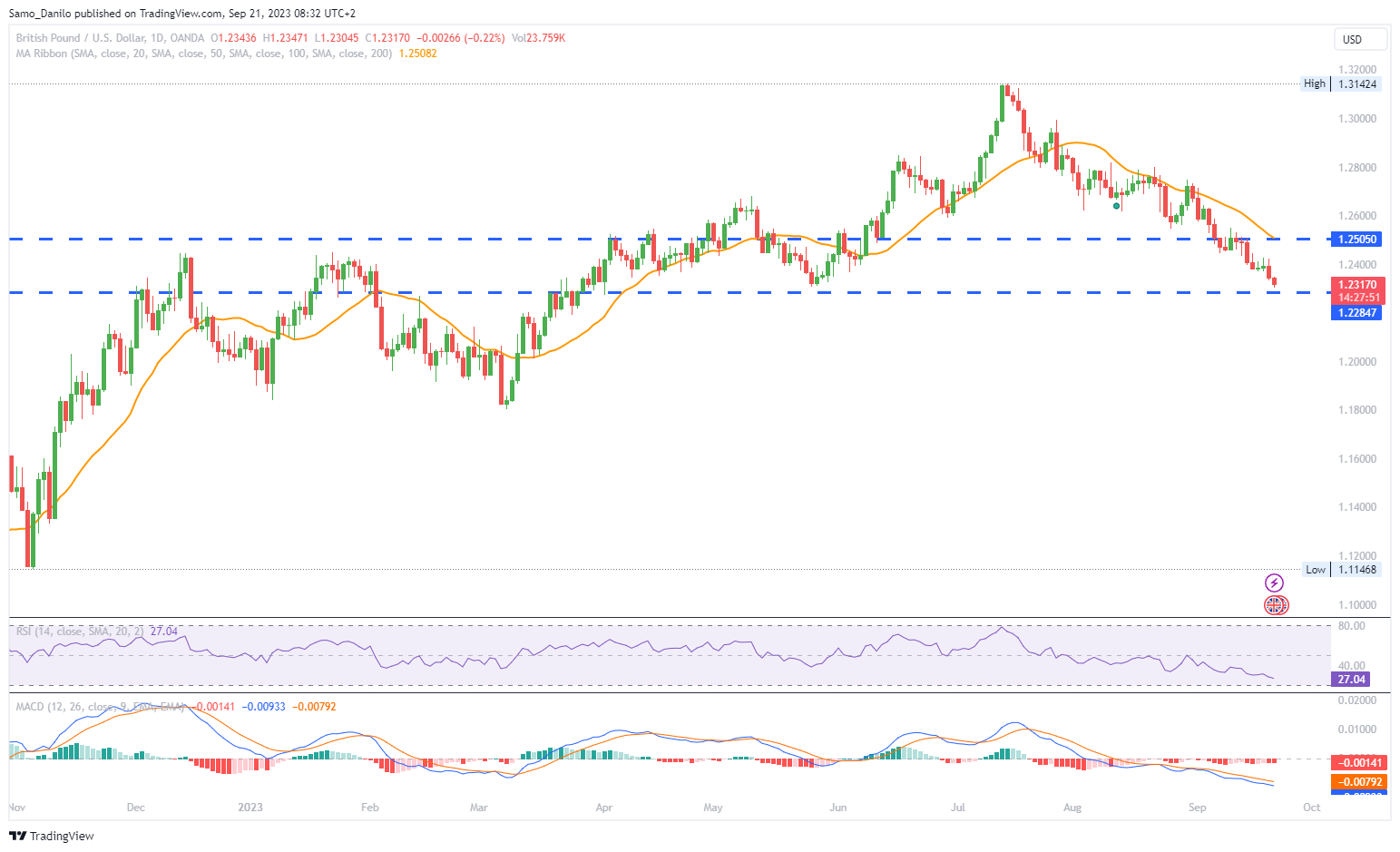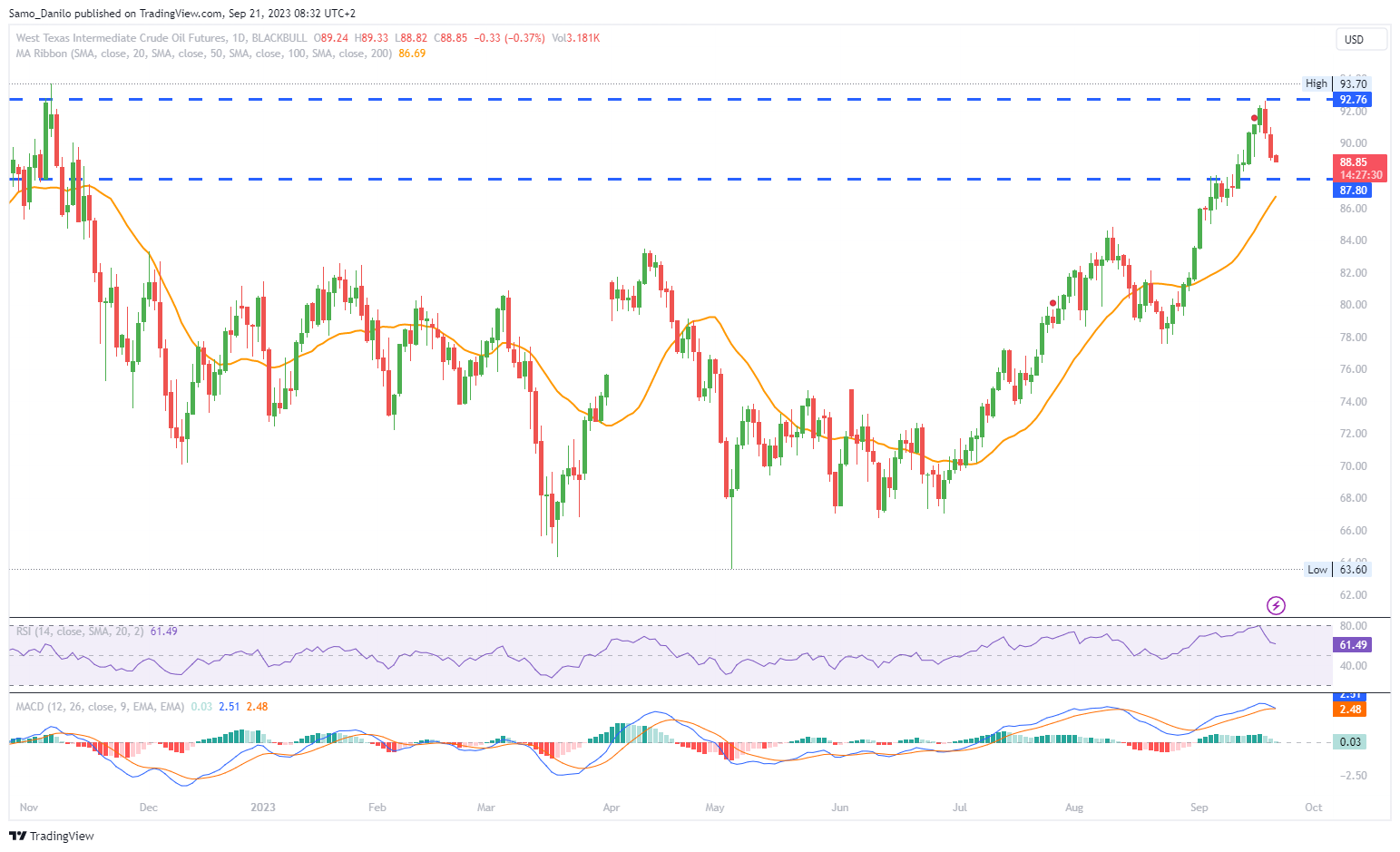EURUSD
- The EUR/USD currency pair experienced a significant decline from its weekly highs, dropping from levels above 1.0730 to around 1.0650. This sharp decline was primarily driven by a stronger US Dollar following the Federal Open Market Committee (FOMC) meeting.
- From a technical standpoint, the EUR/USD remains within a downward channel, indicating a clear bearish bias in the pair's price movements.
- The FOMC meeting concluded with no surprises, as the Federal Reserve decided to keep its interest rate target range unchanged at 5.25-5.50%. This decision was made unanimously. The statement released following the meeting showed little deviation from the one issued after the July meeting.
- In the coming days, several economic events are expected to impact the EUR/USD pair. These include Jobless Claims, the Philly Fed Index, and Existing Home Sales scheduled for Thursday. Additionally, preliminary PMI data from both Eurozone and the United States will be closely watched on Friday.
- Eurostat is set to release preliminary Consumer Confidence data, which could provide insights into consumer sentiment in the Eurozone. This data, along with decisions from central banks like the Swiss National Bank and the Bank of England, could influence the Euro's performance.
Closing statement: The EUR/USD experienced a significant decline following the FOMC meeting, driven by a stronger US Dollar. The technical outlook suggests a bearish bias, and upcoming economic events, including PMI data and central bank decisions, are expected to influence the currency pair's movements in the near term.
GBPUSD
- The GBP/USD currency pair faced significant bearish pressure and reached its lowest level in nearly four months, dipping to around 1.2300 during the European morning. It later saw a slight recovery.
- The Office for National Statistics reported that UK inflation, measured by the Consumer Price Index (CPI), decreased slightly to 6.7% on a yearly basis in August, down from 6.8% in July.
- More notably, the Core CPI, which excludes volatile food and energy prices, softened to 6.2% from 6.9% in the same period. Both of these figures fell below market expectations, resulting in weakness in the Pound Sterling against other major currencies.
- Following the release of the inflation data, the probability of the Bank of England (BoE) maintaining its policy rate steady on Thursday increased to 50%, up significantly from 20% earlier in the week. These dovish BoE expectations led to a decline of more than 3% in the 2-year UK gilt yield.
- In the late American session, the US Federal Reserve has announced its decision on interest rates and kept them unchanged at the range of 5.25-5.5%, as expected.
| SMA (20) | Falling |
|
|
| RSI (14) | Slightly Falling |
| |
| MACD (12, 26, 9) | Slightly Falling |
|
Closing statement: GBP/USD faced substantial bearish pressure due to lower-than-expected UK inflation data. The data raised expectations of a stable policy rate from the Bank of England (BoE). The currency pair will likely continue to be influenced by central bank decisions, economic data, and broader market sentiment.
GOLD
- Gold price experienced significant volatility on Wednesday, with two-way price swings. It ultimately settled with modest losses for the day. Gold price initially surged to reach a fresh three-week high at $1,947. This increase was in anticipation of the Federal Reserve's interest rate decision, driven by traders taking profit on their long US Dollar positions.
- The Federal Reserve announced its interest rate decision during the day. As the Fed revealed its hawkish stance, indicating the likelihood of another rate hike before the year-end, the US Dollar rebounded strongly. This rebound triggered a $20 pullback in gold price.
- The Summary of Economic Projections released by the Fed showed that most members believe another rate hike is probable before the end of the year. Fed Chair Jerome Powell mentioned that the dot plot, which indicates member forecasts, should not be viewed as a set plan. Forecasts for next year displayed reduced expectations of rate cuts.
- The Fed's decision and statements were viewed as hawkish. This prompted a rise in US bond yields to multi-year highs and led to declines in the stock market.
- According to the CME Group FedWatch Tool, markets still estimate a nearly 40% chance that the Fed will raise interest rates by another 25 basis points before the end of the year.
| SMA (20) | Slightly Rising |
|
|
| RSI (14) | Slightly Falling |
|
|
| MACD (12, 26, 9) | Slightly Rising |
|
Closing statement: Gold price saw considerable fluctuations on Wednesday, initially reaching a three-week high but later retreating due to the hawkish tone of the Federal Reserve. The future direction of Gold will likely continue to depend on central bank decisions, economic indicators, and shifts in market sentiment.
CRUDE OIL
- Western Texas Intermediate (WTI), the US crude oil benchmark, is currently trading around $88.90 as of Thursday.
- WTI prices faced some follow-through selling, dropping to nearly a weekly low of $88.60. This decline came after the Federal Reserve (Fed) announced that it would hold interest rates unchanged and delivered hawkish comments during its meeting on Wednesday.
- Saudi Crown Prince Mohammed bin Salman made remarks on Wednesday, stating that OPEC's decision to cut oil production was based on the goal of maintaining market stability. He emphasized that it was not intended to assist Russia in its war in Ukraine.
- The US Energy Information Administration (EIA) reported that crude oil stockpiles decreased by 2.135 million barrels. This decline followed a previous week's increase of 3.954 million barrels. The market had expected a drawdown of 2.2 million barrels.
- In the near term, oil traders will closely monitor the release of US weekly Jobless Claims, the Philadelphia Fed Manufacturing Index (Philly Fed), and Existing Home Sales. These data points could provide further insights into the economic conditions influencing oil prices.
| SMA (20) | Rising |
|
| |
| RSI (14) | Falling |
|
|
|
| MACD (12, 26, 9) | Slightly Falling |
|
Closing statement: WTI crude oil prices experienced a decline following the Fed's decision to hold interest rates unchanged and its hawkish comments. Market sentiment around oil prices remains sensitive to a range of factors, including supply dynamics, geopolitical events, and economic indicators.
DAX
- On Wednesday, the DAX, the German stock market index, recorded a gain of 0.75%. This gain partially reversed a 0.40% decline from the previous day, with the DAX closing the session at 15,782 points.
- The People’s Bank of China (PBoC) left its loan prime rates unchanged on Wednesday. This decision was in line with expectations, as recent economic indicators from China had shown signs of improvement, particularly on the economic front.
- German producer prices played a role in boosting investor sentiment on Wednesday. These prices increased by 0.3% in August, a positive shift compared to the 1.1% decline observed in July. This figure exceeded economists' expectations, which had forecasted a 0.2% rise.
- It's important to note that speeches from key figures at the European Central Bank (ECB), including Executive Board member Isabel Schnabel and ECB President Christine Lagarde, were scheduled for the day. Hawkish comments or concerns related to inflation from these ECB representatives could impact market sentiment, especially in the context of the latest developments from the Federal Reserve (Fed).
- The DAX faces downside risks, especially in light of a more hawkish stance from the Fed and the ECB's concerns about inflation. However, the DAX could find some support from improving macroeconomic conditions across the euro area.
| SMA (20) | Neutral | |
| RSI (14) | Slightly Falling |
|
| MACD (12, 26, 9) | Neutral |
Closing statement: The DAX experienced a modest gain, reflecting positive economic data from Germany and cautious optimism following the PBoC's decision to maintain loan prime rates. However, the market remains sensitive to central bank communications, and any hawkish signals could influence investor sentiment.





